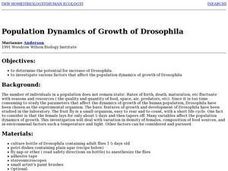Curated OER
Water
Students examine water, its function and how much you should consume. In this water lesson plan students study water and why it is important, how much you should drink and what its functions are in your body.
Curated OER
All Wrapped Up
Pupils work in teams to identify and sort types of packaging used in food production. They consider ways to reduce the environmental impact of packaging and reflect how consumer choices play a role in trash production.
Curated OER
Population Dynamics of Growth of Drosophila
Students experiment with Drosophila to determine if density of female flies, food sources, temperature and light affect the population dynamics of growth. Students graph their data and compare their results to the number of human...
Curated OER
Population Dynamics of Growth of Drosophila
Students investigate population dynamics such as variation in density of females, composition of food sources an environmental factors such as light and temperature on Drosophila. They then relate their findings to human populations and...
Curated OER
Who Can Harvest A Walleye?
Seventh graders investigate the concept of how an ecosystem is put together while conducting research using a variety of resources. They correctly differentiate between a herbivore and carnivore by placing them in the order of hierarchy...
Curated OER
My Farm Web
Third graders explore agriculture by viewing video clips in class. In this farm animal activity, 3rd graders identify the animals mostly eaten that come from farms and the types of food they consume before they are eaten by us. Students...
Curated OER
Commercial Uses of the Rainforest
Students go on a scanvenger hunt to find products (from a provided worksheet) that have ingredients that come from the rainforest. They then decide if the products are really needed by consumers and make a display of them.
Curated OER
Amoeba
In this amoeba worksheet, students read about the structures of the amoeba and their functions. They answer twelve questions about the amoeba and color given structures on a diagram of an amoeba.
Curated OER
Space Age Technology Comes to Earth
Young scholars explore eight career and technical areas and make connections with business, family and consumers, and technology. They examine and describe how agriculture and natural resources impact our quality of life. They explore...
Curated OER
From Farm to Table
It's important for students to understand where our food comes from and the environmental implications of agriculture.
Curated OER
Why Is My Bread Fuzzy?
Students explore the organisms that live on counters or surfaces in the classroom. In this mold experiment, students observe mold in different conditons. Students record their observations on a worksheet. Students understand how mold...
Curated OER
Best Breakfast Authors
Third graders write a story. In this breakfast authors lesson, 3rd graders write about a breakfast food and why it is a good selection. Students may illustrate stories and share with their peers.
Curated OER
A Teeth Changing Experience
Students research human health by reading an educational story in class. In this oral health lesson, students identify the importance of brushing their teeth and consuming calcium. Students read the book A Teeth Changing Experience and...
Curated OER
Oklahoma's Berry Best
Ask your learners to complete activities related to Oklahoma's agriculture, berries in particular. The lesson is cross-curricular and has class members investigate an article about berries, write an acrostic poem, and discuss new...
Curated OER
Healthy Body Image: A Lesson Plan for High School Students
How does your class view themselves? High schoolers explore body image through a series of four activities. Groups collaborate to examine the changes we experience as a part of growing up, how the media influences body image, and healthy...
Curated OER
Ecosystems - Plants and Animals Together
Students study the biotic and abiotic factors of an environment. In this exploratory lesson students examine the different trophic levels and how organisms are connected.
Curated OER
Kingdom Fungi
In this kingdom fungi instructional activity, students conduct an experiment creating and observing dough. They describe what happened to the dough while they observed it and name the type of fungus is the yeast added. Students also...
Curated OER
People and the Ocean
Students view a demonstration of the ocean and what we can do to help it, and also identify seafood items that students would order on a menu. In this ocean lesson plan, students learn how people are connected to the ocean and how we can...
Curated OER
Let's Sort a Salad
Students examine edible plants by identifying salad ingredients. In this botany lesson, students discuss the different vegetables that can be eaten in a salad and draw them on a worksheet. Students review vegetable vocabulary and examine...
Curated OER
Insects!
Students explore the diet of insects. In this "insects" biology lesson, students take a nature walk and collect various natural materials they think may be eaten by insects. Students sort and classify these materials into three diet...
Curated OER
Animal Adaptations
Students focus on the pelts of fur-bearing animals native to Iowa to discover their different adaptations. In this animal adaptation lesson, students work in groups and examine various pelts to find information about the animals habitat...
Curated OER
The Discovery of Photosynthesis
Young scholars explore how scientists discover photosynthesis. In this biology lesson plan, students identify the basic requirements for photosynthesis to happen. They recreate past scientists' experiments and record their observations.
Curated OER
Where to shop?
Pupils study a topic of an environmental nature that is relevant to them (as individuals) on a local level, but with global implications. They consider whether their family's shopping habits have any lasting effects on the environment.
Curated OER
Strands Walk An Ecological Observation
Students examine an ecosystem and analyze the role of two abiotic factors in the ecosystem. In this ecosystem lesson students complete an activity on their ecosystem.

























